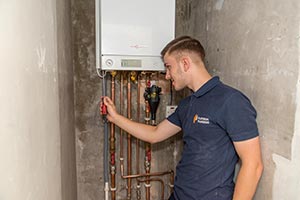
Heating and hot water are factors we don’t realise that we take for granted until they stop working mid-winter. One causing fault, which can be commonly found within properties all over the UK, is a sudden loss or gain of pressure within your boiler, but what exactly is this and how simply can it be resolved?
What is boiler pressure?
Simply put, boiler pressure is the balanced combination of water and air within your sealed boiler system. An uneven combination of these factors can cause a pressure fault.
A balance of too much air and not enough water will result in low pressure, preventing water flow to the radiators throughout your property.
Not enough air and a heavy imbalance of too much water will cause an unnecessary amount of water to rush through your radiator systems. This is known as high pressure.
How to identify a boiler pressure fault
The gauge on your boiler should lie between 1 and 2, with 1.5 being a precise, ideal measurement. However, it can be difficult to hit this pressure exactly. Anything outside of this bracket will indicate if your boiler is experiencing a high or low pressure fault which requires attention.
There may be some signals surrounding your radiators which alert you that your boiler is experiencing a pressure error and that your gauge needs an examination, such as a leak within your system, or a radiator which needs recurrent bleeding.
How to resolve a boiler pressure fault
There are a few simple steps that you are able to take upon your boiler should you feel safe in doing so. However, Gas Safe registered plumbers are on hand to carry out this step if you feel unsafe in doing so. If you begin to make amends but experience a struggle or find that it hasn’t aided the issue, or if you are advised to use tools for this action, then you should call for a professional to assess your boiler, pipes and radiators as soon as possible.
Follow these simple steps to fix your low-pressure boiler:
- Switch your boiler off and allow it to cool
- Fit and observe the filling loop, ensuring that both ends are secured correctly
- Open both valves to allow a flow of cold water from the mains into the system
- Monitor the pressure gauge and once it reads 1.5, close both valves
- Turn your boiler back on or reset it by us of the ‘reset’ button (depending on your boiler type)
- Remove the filling loop and store in a safe place in case it is needed in the future
Follow these simple steps to fix your high-pressure boiler:
To lower the pressure, you will simply need to bleed your radiators. To do this you will need to:
- Find your radiator key, or an alternate aid, to allow you to gain a tight but comfortable grip
- Locate the radiator valve. This will most likely will be found at the top corner
- Place the radiator key or alternate piece of equipment on the valve and slowly rotate it anti-clockwise
- Listen for a release of air, which will then be followed by a leak of water. Let out only a small amount of water
- Repeat this across all radiators within your property until the pressure gauge reaches a happy and healthy 1.5
If you are in any uncertainty in regards to the pressure of your boiler and require a professional assessment by a Gas Safe registered engineer, then do not hesitate to get in touch with a member of our Platinum Plumbers team. Give us a call on 020 8855 0361 or drop us an email at stating your query, and we will get back to you as soon as possible.


